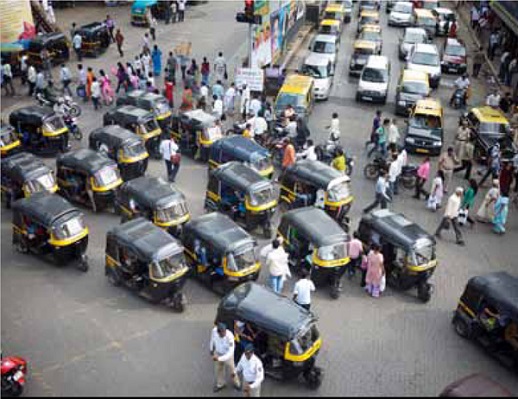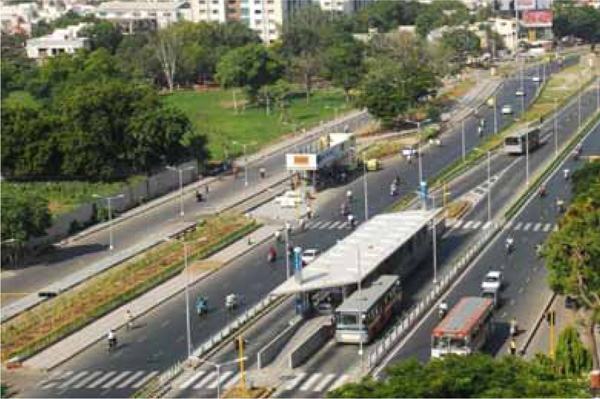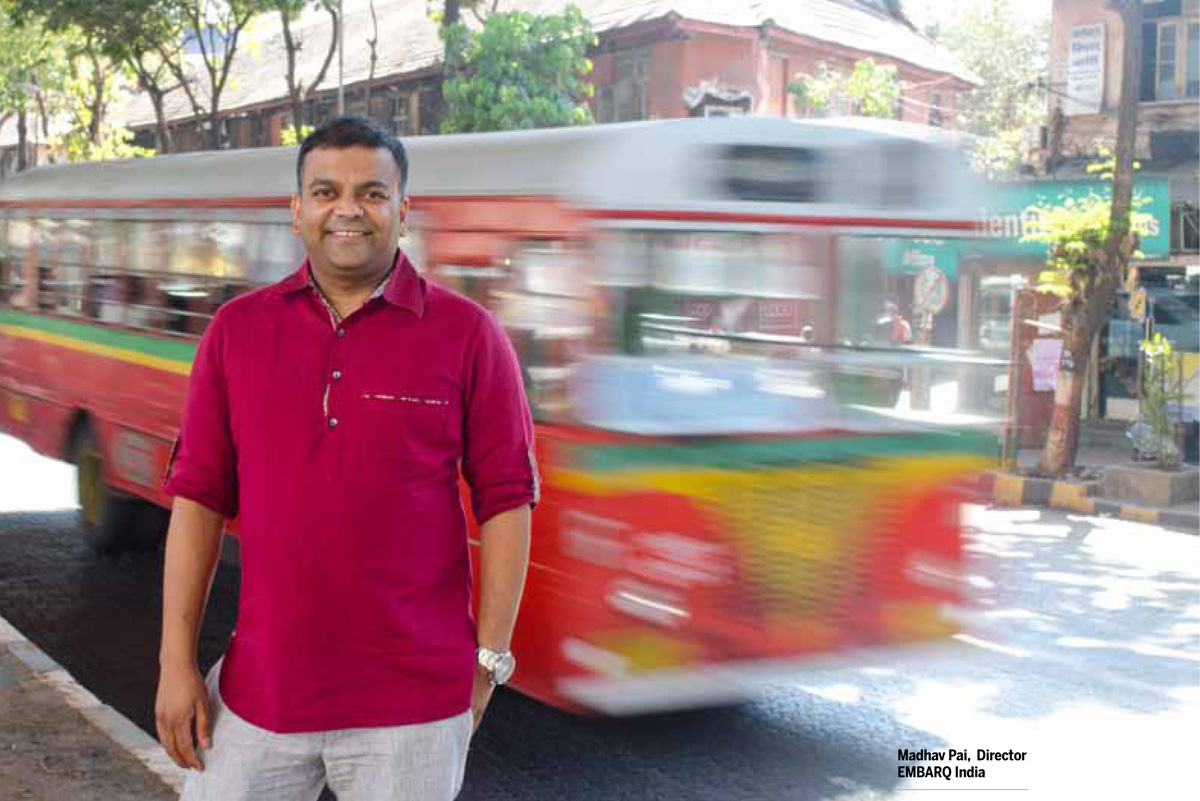Riddled as our cities are today with crumbling infrastructure, sustainable transport has been a distant dream so far. What ails our public transport systems? What could be the possible way forward? In a bid to find answers, My Liveable City met Madhav Pai, right after Embarq’s annual conference ‘CONNECTKaro’ on sustainable transport. Excerpts from an enlightening conversation:
How was EMBARQ conceptualized? What role does it intend to play in India?
EMBARQ (the WRI Centre for Sustainable Transport) is a not-for-profit initiative of the World Resources Institute (WRI), an environmental think tank in Washington, D.C. that goes beyond research to find practical ways to protect the earth and improve people’s lives. Its mission is to ‘catalyze and implement environmentally and financially sustainable urban transportation solutions to improve the quality of life in cities’. EMBARQ India is part of a global network of EMBARQ Centers (founded in 2002), which include Centers in Mexico, Brazil, the Andes, Turkey and China. EMBARQ Centers work to provide global technical capacity, albeit locally, to cities in the developing world to help implement sustainable solutions to the problems of urban mobility.
EMBARQ India seeks to catalyze and help implement sustainable transport solutions to improve the quality of life in Indian cities.
It began work in the country in 2008, with a staff of only two people working on one project. In the span of five years, the organization has grown to 30+ staff, with offices located in Mumbai, Bengaluru and New Delhi. It has active engagement on project work in 20+ cities, spanning various areas of sustainable transport. Significant projects where EMBARQ India has provided technical expertise are implementation of BRT (Bus Rapid Transport) systems in Ahmedabad, Indore, Bhopal and Surat and setting up and reorganizing of bus systems in Jaipur, Ahmedabad, Rajkot and Bengaluru.
Other areas of expertise include intermediate/ informal public transport, walking and bicycling infrastructure and transit-oriented development (TOD). EMBARQ India has also produced high quality publications, such as Bus Karo: A Guidebook on Bus Operations and the Role of Auto rickshaws in Sustainable Transport. EMBARQ India would like continue to play the role of a catalyst for sustainable transport till we see this trend becoming mainstream.
Indian cities, especially the tier II cities, are at a very crucial stage of development. There is a strong need for sustainable and equitable development. How can the government make urban transport a means to achieve these goals?
Tier II cities are the growth engines for the future. Let us consider the example of Surat, which is a tier II city with a huge potential for development (it ranked 8th in India with a GDP of $ 40 billion in 2011-2012). Looking at the mode share in the city, buses handle 1% of the traffic whereas auto rickshaws account for 21% of the total trips. 46% of the total trips are made on foot or bicycles and only about 1% of the trips are made by car (the remainder of the trips (30%), are made on two-wheelers). Yet, the public transport system was withdrawn in 2007 (BRT has only recently been introduced).
The government must intervene in the growth of these cities and steer it in the correct direction, otherwise, we will be faced with the same predicament present in the tier I cities. Decision makers need to focus on the underlying vision of the National Urban Transport Policy (NUTP), which is ‘move people and not cars’. We need to stop building roads for cars and start building streets for people.
Provision of convenient, reliable, affordable and user-friendly public transportation systems and non-motorized modes of transportation are the need for tier II cities in India. Three-wheelers are also an important mode of transport in tier II cities and the government needs to ensure that they function in tandem with the other public transport services to provide citizens with seamless connectivity and enhanced mobility.
 |  |
The demographics of Indian cities present very different scenarios compared to many of their international counterparts. Which public transport system is the most viable for Indian cities and why?
Indian cities need to invest in high quality bus systems. Cities should target to serve more than 50% of motorized trips by bus. Currently, most Indian cities lack basic public bus systems, which are cost effective, flexible and can provide capacity based on demand and a very wide public transport coverage. Cities need to invest heavily in upgrading, modernizing and making their bus systems more viable. London, Seoul and New York have done this very successfully in the last decade. On major arterials, where buses get stuck in traffic, we need to provide bus rapid transit: a bus-based mass transit system with features like dedicated lanes for buses, stations, prepayment, branding and centralized control. In addition to Indian cities such as Ahmedabad, Rajkot, Indore, Surat and Bhopal, which have adopted it successfully, 140 cities (such as Curitiba, Bogota and Guangzhou) around the globe have set excellent precedents.
The scooter and bike have become integral modes of transport for Indian families. The ratio of ownership of 2-wheelers to 4-wheelers is 8:1 approximately (2009 study). What repercussions does this have on roads and how should the system respond?
Two-wheelers have been an intrinsic part of the traffic makeup of Indian cities for almost three decades now. They account for up to 30-50% of the traffic in the majority of our cities. In most tier II cities two wheelers are the largest motorized mode. They are also the fastest growing mode for Indian cities. Contrary to popular belief, these two-wheelers are clean since most of them are four-stroke and very fuel efficient.
However, safety is a major concern. Recent data shows two-wheeler riders (23%) account for the largest share of road fatalities and India records the maximum number of deaths from motorized two-wheeler accidents in the world.
We need to do more than just enforce helmets. There is an urgent need to rethink the design of our roads and of the motorcycle itself. We recently released a working paper titled Motorized Two Wheelers in Indian Cities: A Case Study of Pune to explore some of these issues in detail.
Parking spaces in public areas have always been considered a birth right by car owners. When a traffic roundabout becomes a parking area instead of a green space at a large intersection, we are going fundamentally wrong somewhere. Your take on this?
A progressive, well-implemented parking policy could solve most of the traffic related problems our cities face. A good parking policy would mean no free parking, little on-street parking and paid off-street parking. Priced parking will ensure people understand the true cost of owning a car. No on-street parking will ensure people have space to walk and cycle. Revenue from parking can be used to cross subsidies public transport.
Parking is one of the gravest problems burdening urban infrastructure today. So, the parking problem is as much an opportunity as it is a challenge.
Hawkers are seen as encroachers on our roads and pavements. At the same time, they are part of a very important local economy. How can this issue be mitigated?
Hawkers are a source of self-employment to the poor and also cater to the needs of the urban poor in an affordable manner. According to a study conducted on vendors by EMBARQ India in MIDC Marol, it was found that the industrial/business district, which has a floating population of 1.86 lakh per day, is home to only a few restaurants within walkable distance. It was observed that there were no formal eating places in the vicinity that tertiary workers such as security guards could afford. The cost of a meal provided by a restaurant in the area is four and a half times higher than that of a meal bought from a vendor. It was also found that vendors cater to 90% of the floating population across income groups in MIDC Marol. The reason for this trend is that vendors are strategically situated to be able to provide services at walkable distances. Also, the study found that vendors catered to customers from all income groups. We need to change the debate around vendors from their encroaching upon public space to their role in facilitating the creation of walkable business districts and neighborhoods. The relationship between the informal sector and accessible, walkable and safe spaces is mutually beneficial and both the parties contribute to each other’s success. Also, with the National Street Vendors Bill having recently been passed by the Rajya Sabha, planners and local authorities will need to take into account the benefits offered by this group and effectively incorporate them into the design of public spaces especially pedestrian corridors and mobility routes. So not only do we need space for walking and cycling we also need space for vendors. And the way to create this space is to take it away from parking and cars.
All EMBARQ India publications are accessible at http://embarqindia.org/publications




Comments (0)